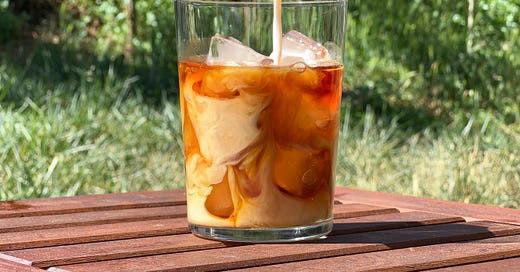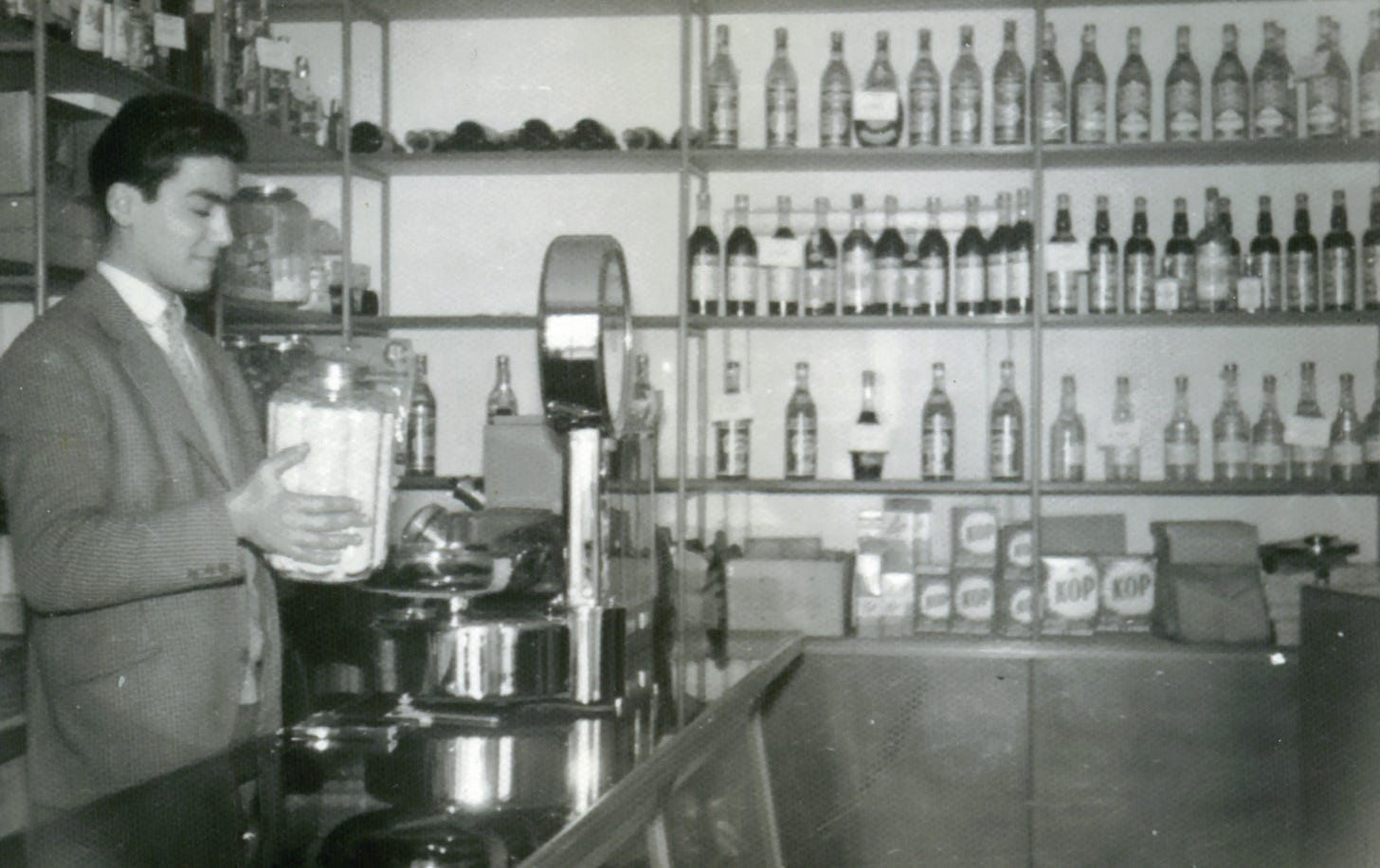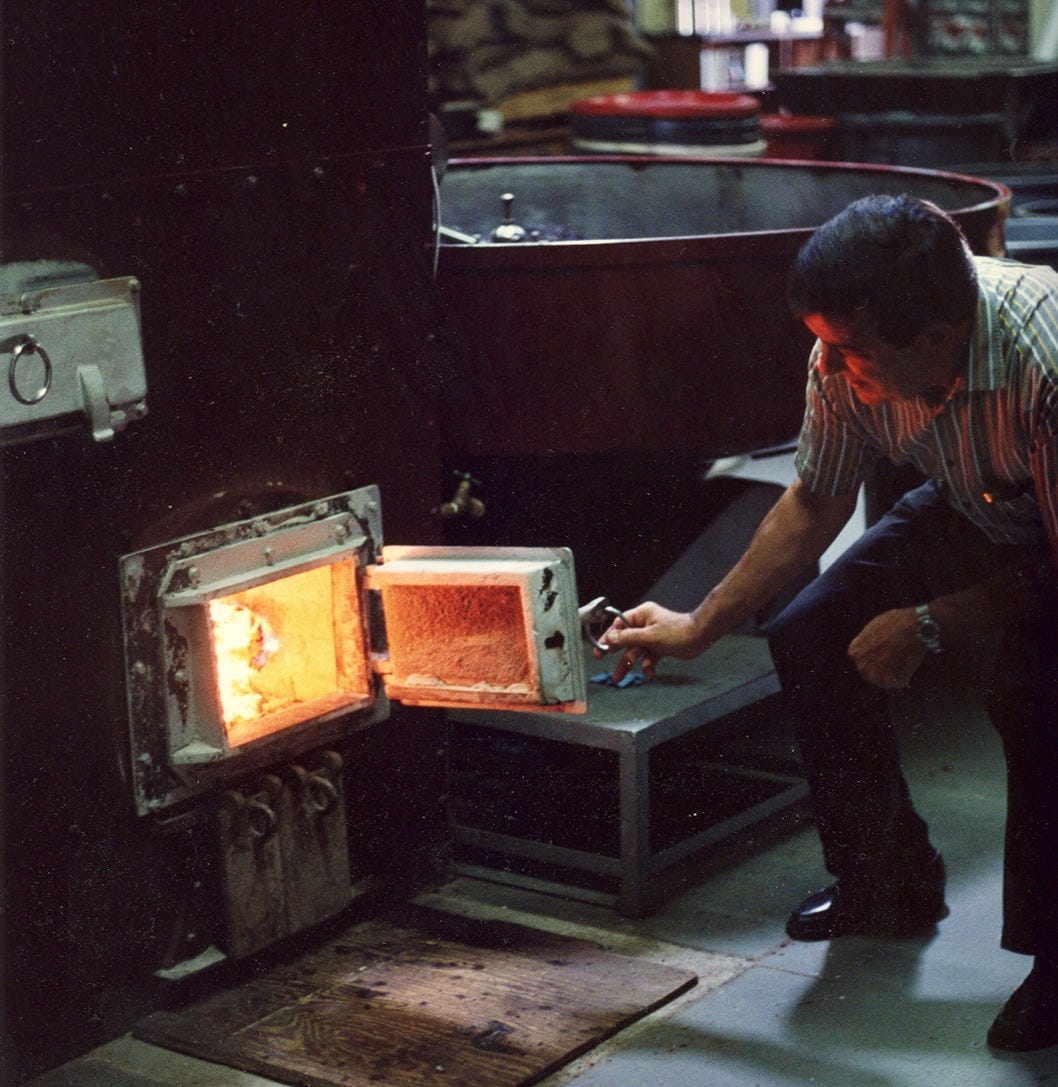Happy June, everyone! As we head toward the official start of summer, I’m excited to share a story that I’ve been saving for iced coffee season. When I first started collecting recipes from California’s home cooks two years ago, Luigi Di Ruocco, the Vice President of Mr. Espresso, was one of the first people to share his family’s story with me. The interview below is a little bit different than some of the others I publish here, because it’s largely about the business, rather than home cooking, but I’m fascinated by what this family’s story tells us about how we, as Californians, changed our coffee preferences over the past few decades, and that’s definitely something that has impacted home cooking, as well as cafés and restaurants.
Luigi also shared a number of fantastic recipes, including an absolutely delicious horchata cold brew. That recipe is below (and others will follow in future newsletters; subscribe if you don’t want to miss them). But first, here’s our conversation, condensed and edited for clarity.
Luigi Di Ruocco
Can you tell me about your family’s history in California and how your business started?
My father founded Mr. Espresso, along with my mother, in 1978. They both immigrated here, to the United States, in the mid-70s. My brother and sister were born in France, and I was born here, in ’77.
My dad is originally from Salerno, Italy, and my mother is originally from Normandy, France. They met when they were on vacation in Nice one year, and they maintained communication. Eventually, as they furthered their relationship, he moved to France to be near her. They got married and moved to Paris. After they came to the United States, my father was working for Otis Elevators—that was kind of his trade at the time, he was doing that in France—but as an Italian gentleman who was very accustomed to drinking espresso, he noticed that it was very difficult to find anything in the United States. In San Francisco, in North Beach, you could go to Caffe Trieste for a good espresso. (I believe they’re credited with being the first place on the West Coast to serve espresso, in 1957.)
In Italy, they don’t drink any drip coffee at all. In fact, traditionally, most Italians do not like drip coffee. Jokingly, they call it “dirty water.” They invented espresso around the year 1900, and since then, everything else kind of faded away. Even today, in Italy, drip coffee is not something Italians drink in the morning. It’s not part of the coffee culture. Right now, as the craft coffee wave is being introduced into Italy, it’s starting to take hold a little bit, but the entire coffee culture is still virtually entirely about espresso.
Americans were used to a coffee house culture—drinking a large cup of coffee, or a refillable cup of coffee, and sitting down in a coffee shop or a coffee house/diner kind of setting. And the coffee was generally weak, so you had to drink a lot of it. It was more about sitting down and being at your leisure and reading a book or having a chat with somebody. In Italy, you drink espresso standing up at a bar, and it’s less than an ounce of liquid, and you’re drinking it in less than a minute. So it’s no surprise that espresso didn’t take off quickly in the United States. It was kind of a weird drink, if you think about it.
From the post-WWII period until the late ‘60s, the coffee in this country was terrible. This was due to consolidation in the coffee roasting industry, rationing due to wars, coffee market volatility, the advent of marketing and advertising, and a bunch of other reasons. But the culmination of all of these factors was that the entire United States was drinking lightly roasted, low quality, weakly brewed coffee. I call it diner-style coffee.
My dad saw an opportunity. He started to import machines (just a few at a time) from Italy, and he would go around and try to sell them to Italian restaurants or delis or coffee shops. Around that time, people figured out that you could make lattes. If you make a latte, it’s a bigger cup, so you can drink it longer. And espresso is pretty bitter, but when you add a bunch of milk, it kind of evens out the flavor. So, the latte became the vehicle that helped espresso take off. Lattes were something that was invented in the United States. In Italy you just take espresso, and if you do take milk with your espresso, you’re going to be taking a small amount of milk, and it’s manifested in the drink called the cappuccino. The cappuccino is a drink that you just have in the morning, to sort of satiate yourself and feel a little bit more full. If you have a cappuccino at all. There’s a joke that if you order a cappuccino in Italy after 10:30 in the morning, then you’re a tourist. They don’t eat big breakfasts. They’re usually on the go in the morning, so the milk in the cappuccino fills them up a little bit.
So, he was in the right place at the right time, and he was one of the pioneers. He was selling machines, and there was nobody else around really specializing in espresso machines at the time. He was the first guy on the West Coast who was able to kind of put it all together. Around this time, Alice Waters and Julia Child were looking backwards in time or to other cultures and traditions and trying to learn from them and introduce those concepts to the United States. Similarly, my father was thinking about espresso, and he played a major role in the context of espresso and specialty coffee. He was in a unique position because he knew how the machines worked, and about European standards, and a little bit about how things worked here.
He quit his job in the elevator company, and Mr. Espresso started out of our home garage. I was born in ’77, so the house that I was born into became the place where the company started, in ’78, in the garage. Within a few years, he also started to roast coffee. Coincidentally, as a teenager growing up in Italy, he had worked at a coffee roasting company in Salerno, and during his time there, he learned about roasting coffee with wood. At that company, they use wood to heat the roasters. Here in the United States, nobody was roasting coffee with wood. He was the first person in the United States to roast coffee with wood.
The reason you roast with wood—I’ll kind of summarize this quickly, because it can be a bit of a rabbit hole—but there’s moisture in the wood, and when you burn the wood to heat the coffee beans that are turning in the drum above the fire box, there’s a humidity that’s produced in the drum, along with the heat. So, you’re extending the roasting process for a longer period of time, due to that humidity. The coffee is roasting at a very high temperature, but the humidity is helping to slow it down. So, you have a slow, humid roast, and the slow humid roast develops the body in the coffee. Slow roasting over an oak wood fire creates a coffee with lower acidity that is fuller bodied and sweeter.
From there, he started wholesaling as a full equipment and coffee and service provider. That quickly became our bread and butter. He started to supply restaurants and cafes and delis and coffee houses with our equipment, our coffee, our service and maintenance, and support. And that’s still our focus today. We’re family owned and operated. Me and my brother and sister manage the day to day. My father and mother are still involved. And we still have the same kind of values, the Old World meets New World approach to coffee.
What kinds of coffee drinks does your family make at home, and what kinds of foods do you and your family cook?
My wife is Cambodian and Vietnamese, but she identifies as mostly Cambodian. So, she cooks a lot of Cambodian at home. The flavors are very pungent; it’s a very complex and amazing cuisine. Her father was Vietnamese, but he went to Cambodia and met her mother. They came over during the refugee era. Her two older brothers were born in a refugee camp in Thailand. They arrived in Seattle, where my wife was born, and then they came down to the Bay Area later on. In addition, when you came over, you made new family when you got here—the people you were with, the people around you, and the people you came over with. They became your community and your family. All those folks in her family are Cambodian, and that’s what she mostly identifies with.
But she also cooks a lot of Italian- and French-based, Mediterranean-based foods. And she’s helped me with recipes for coffee drinks. The other day she made me a Thai iced tea with espresso. She really likes drinking Thai iced tea, so she wanted to make me a recipe with Thai iced espresso. A few years back she created an horchata cold brew. She’s always been coming up with ideas for coffee drinks.
Mary’s Horchata Cold Brew
This recipe was created by Luigi’s wife, Mary. It pairs the company’s rich cold brew with homemade horchata for a perfect blend of sweetness, bitterness, and creaminess. (It’s so good, in fact, that I’m going to turn some of my next round into ice cream!) You can make this in one big batch or keep the cold brew and horchata separate and mix them to your desired flavor—and keep some of the horchata on hand for any kids who might get jealous! If you don’t have time to make your own horchata, make sure to get a high-quality version for this; local taco spots, where they make it in small batches, will offer the best quality.
Serves 8
4 cups Cold Brew Coffee (recipe below)
4 cups Horchata (recipe below)
Ice
Combine the cold brew and horchata in equal parts, and serve over ice. (Alternatively, fill a cup 2/3 of the way with ice and add the coffee and horchata one at a time, adjusting the ratio to your taste).
Cold Brew Coffee
Makes 4 cups
½ cup (112 grams) coarsely ground coffee
4 cups (860 grams) cold water
Combine the coffee and water in a 4-cup (or larger) French press. Let the mixture sit at room temperature for 24 hours.
Depress the plunger, and pour the cold brew into a jar or storage container. Refrigerate until ready to use. Dilute with ice when serving.
Horchata
Makes ~4 cups
1 cup uncooked white rice
1 cup water
1 cinnamon stick
2 teaspoons ground cinnamon, separated
3 cups whole milk
1 cup heavy cream
1 teaspoon vanilla extract
Cinnamon Simple Syrup (recipe below)
Put the rice, water, cinnamon stick, and 1 teaspoon ground cinnamon in blender or a deep container (if using an immersion blender). Blend ingredients together until the rice and cinnamon sticks are broken into small, uniform pieces.
Cover the mixture, and let it sit at room temperature for 24 hours.
After 24 hours, strain the liquid through a cheesecloth into a large storage container, squeezing to remove all of the liquid.
Add the milk, cream, vanilla extract, and remaining 1 teaspoon of ground cinnamon to the liquid, and add cinnamon simple syrup to taste. Refrigerate until ready to use.
Cinnamon Simple Syrup
2 cinnamon sticks
1 cup water
1 cup granulated sugar
In a small pot, brown the cinnamon sticks over low heat until they are fragrant (but be careful not to burn them).
Add the water and then the sugar to the pot, and bring the mixture to a boil, stirring.
When the mixture has boiled (and the sugar has dissolved), remove the pot from the heat. Pour the syrup (with the cinnamon) into a heat-proof storage container, and let it stand at room temperature for 24 hours to infuse before using.
More California Stories to Read, Watch, and Listen To
If you want to read more about California coffee, check out Eater’s new list of San Diego’s best coffee spots. (You can also check out the Roast! West Coast newsletter and podcast, for coffee info from all over the state.)
At the end of May, the Julia Child Foundation hosted the Taste of Santa Barbara (celebrating the foods of Julia’s last hometown), and the radio show Inside Julia’s Kitchen interviewed two Santa Barbara chefs about what makes the area’s food scene so special. Also last week, CapRadio did a piece about how California’s First Partner, Jennifer Siebel Newsom, is working to get nutritious foods into schools.
If you’re looking for more summery recipe inspiration, Edible Sacramento has a really easy no-egg Apricot Ice Cream, the LA Times has a Tahini-Herb Pasta Salad, the California-based blog Bowl Me Over just posted a recipe for strawberry rhubarb jam that looks lovely, and the San Francisco Chronicle has a recipe for homemade corn dogs as part of Soleil Ho’s review of Nicole A. Taylor’s Juneteenth cookbook, Watermelon & Red Birds.
Photos: Josh Wand, Courtesy of Mr. Espresso (2), Courtesy of Luigi Di Ruocco, Georgia Freedman








